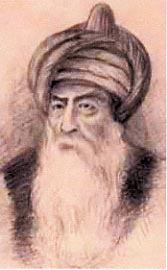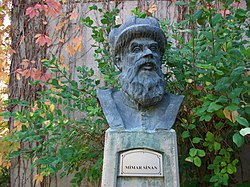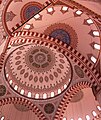معمار سنان
| معمار سنان | |
|---|---|
 طرح مدادی معمار سنان | |
| زادهٔ | حدود ۱۴۸۸/۱۴۹۰ آگرناس، امپراتوری عثمانی امروزه استان قیصریه |
| درگذشت | ۱۷ ژوئیهٔ ۱۵۸۸ (۹۸ سال) استانبول، امپراتوری عثمانی |
| ملیت | امپراتوری عثمانی |
| پیشه | معمار |
| ساختمانها | مسجد سلیمانیه مسجد سلیمیه مسجد شاهزاده (استانبول) مسجد بنیا باشی مسجد کلیچ علی پاشا (استانبول) |
| امضاء | |
 | |

خواجه معمار سِنان آغا (به ترکی عثمانی: قوجه معمار سنان آغا) (به ترکی استانبولی: Mimar Sinan; Koca Mi'mâr Sinân Âğâ; Sinaneddin Yusuf - Abdulmennan oğlu Sinan) (۱۴۸۹–۱۵۸۸) معروف به «معمار سِنان»، معمار رسمیِ چند تن از پادشاهان عثمانی بود.
شرح حال[ویرایش]
معمار سنان در روستای یونانینشین آگرناس به دنیا آمد و به قولی از تبار ارمنی[۱][۲][۳][۴][۵][۶] و یا از یونانیان کاپادوکیایی[۷][۸][۹][۱۰][۱۱][۱۲][۱۳] و یا از آلبانیاییتبار[۱۴][۱۵][۱۶] بود. در جوانی وارد ارتش ینیچری شد و به سرکردگی و لقب «آقا» ملقب شد. در آن زمان در سازههای نظامی و پلها و راهها تخصص داشت. در ۵۰سالگی بهعنوان سرمعمار دربار پادشاهی اقدام به ساخت اماکن مذهبی کرد.
آثار[ویرایش]

کارهای او نمونههای برجسته و اعلای معماری معروف به معماری عثمانی است که تأثیر بسیاری از معماری بیزانس گرفتهاست. شاهکار او را مسجد سلیمیه در ادرنه (آدریانوپول) در بخش اروپاییِ ترکیه میدانند. علاوه بر مسجد شَهزاده و سلیمانیه، از آثار دیگر او در استانبول میتوان به مسجد خرم سلطان، مسجد حاسِکی سلطان، مسجد مهرِماه سلطان، مسجد قلیچ علی پاشا، مسجد سوکوللو مَحمَت پاشا و مسجد رستم پاشا اشاره کرد. مسجد سیاه صوفیا در بلغارستان و مسجد خسرویه حلب در سوریه نیز از جمله آثار معمار سنان در خارج از مرزهای کنونی ترکیه به حساب میآیند.
مرگ[ویرایش]
او در ۱۷ ژوئیهٔ سال ۱۵۸۸ میلادی در استانبول درگذشت و در قبرستان مجاور مسجد سلیمانیه در شمال خیابان معمار سنان جسدش را دفن کردند.
نبش قبر و گمشدن جمجمه[ویرایش]
دانشمندان ترک، در سال ۱۹۳۵، وی را نبش قبر کردند تا جمجمه او را اندازه بگیرند تا بلکه بتوانند اندازه مغز او را که نابغه معماری قلمداد میشد تخمین بزنند، اما از آن به بعد جُمجُمه سنان گُم شد و هیچ وقت به قبر بازگردانده نشد.[۱۷]
میراث[ویرایش]
نام او اکنون در دو نقطهٔ جهان باقی است: یکی در دانشگاه هنرهای زیبای معمار سنان و دوم، گودالی در سیارهٔ عطارد (تیر) که به نام او نامگذاری شدهاست.
نگارخانه[ویرایش]
-
نمای داخلی مسجد شهزاده
-
مسجد سلیمانیه - استانبول
-
نمای داخلی مسجد سلیمانیه
-
مسجد سلیمیه - ادرنه
جستارهای وابسته[ویرایش]
منابع[ویرایش]
- ↑ Fletcher, Richard (2005). The cross and the crescent: Christianity and Islam from Muhammad to the Reformation (Reprinted. ed.). London: Penguin. p. 138. ISBN 9780670032716.
...was Sinan the Old-he lived to be about ninety-an Armenian from Anatolia who had been brought to the capital as one of the 'gathered'.
- ↑ Zaryan, Sinan, Armenian Soviet Encyclopedia, p. 385.
- ↑ Kouymjian, Dickran. "Armenia from the Fall of the Cilician Kingdom (1375) to the Forced Emigration under Shah Abbas (1604)" in The Armenian People From Ancient to Modern Times, Volume II: Foreign Dominion to Statehood: The Fifteenth Century to the Twentieth Century. Richard G. Hovannisian (ed.). New York: St. Martin's Press, 1997, p. 13. شابک ۰−۳۱۲−۱۰۱۶۸−۶.
- ↑ Alboyajian (1937), vol. 2, pp. 1533-34.
- ↑ Jackson, Thomas Graham (1913). Byzantine and Romanesque Architecture, Volume 1. Cambridge University Press. p. 143.
They are many of them designed by Sinan, who is said to have been an Armenian
- ↑ Sitwell, Sacheverell (1939). Old Fashioned Flowers. Country Life. p. 74.
The architect Sinan, perhaps of Armenian descent, raised mosques and other buildings all over the Turkish Empire.
- ↑ Talbot, Hamlin Architecture Through the Ages. University of Michigan, p. 208.
- ↑ Byzantium and the Magyars, Gyula Moravcsik, Samuel R. Rosenbaum p.28.
- ↑ Kathleen Kuiper. Islamic Art, Literature, and Culture. — The Rosen Publishing Group, 2009 — p. 204 — شابک ۹۷۸۱۶۱۵۳۰۰۹۷۶: "The son of Greek Orthodox parents, Sinan entered his father's trade as a stone mason and carpenter." .
- ↑ Sinan: the grand old master of Ottoman architecture, p. 35, Aptullah Kuran, Institute of Turkish Studies, 1987
- ↑ Walker, Benjamin and Peter Owen Foundations of Islam: the making of a world faith, 1998, p. 275.
- ↑ Goodwin 2003, p. 199.
- ↑ Rogers, J. M. (2006). Sinan: Makers of Islamic Civilization. I.B.Tauris: Oxford Centre for Islamic Studies. p. backcover. ISBN 978-1-84511-096-3.
(Sinan) He was born in Cappadocia, probably into a Greek Christian family. Drafted into the Janissaries during his adolescence, he rapidly gained promotion and distinction as a military engineer.
- ↑ Cragg, Kenneth (1991). The Arab Christian: A History in the Middle East. Westminster John Knox Press. p. 120. ISBN 0-664-22182-3.
- ↑ al-Lubnānī lil-Dirāsāt, Markaz (1992). The Beirut review, Issue 3. Lebanese Center for Policy Studies. p. 113. Retrieved 2012-04-05.
- ↑ Brown, Percy (1942). Indian architecture: (The Islamic period). Taraporevala Sons. p. 94.
… the fame of the leading Ottoman architect, Sinan, having reached his ears, he is reported to have invited certain pupils of this Albanian genius to India to carry out his architectural schemes.
- ↑ در جستجوی جمجمه معمار مشهور عثمانی، بیبیسی فارسی
- مشارکتکنندگان ویکیپدیا. «Mimar Sinan». در دانشنامهٔ ویکیپدیای ، بازبینیشده در ۱۵ آوریل ۲۰۱۳.
- Adalian, Rouben Paul (2002). Historical Dictionary Of Armenia. Lanham, Maryland: Scarecrow Press, Inc. p. 349-51. ISBN 978-0-8108-4337-0.
- «Sinan». Encyclopaedia Britannica.
| در ویکیانبار پروندههایی دربارهٔ معمار سنان موجود است. |




